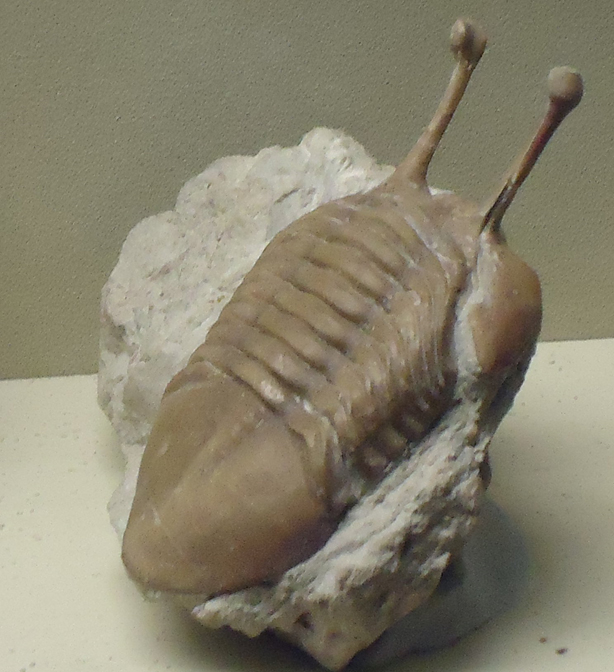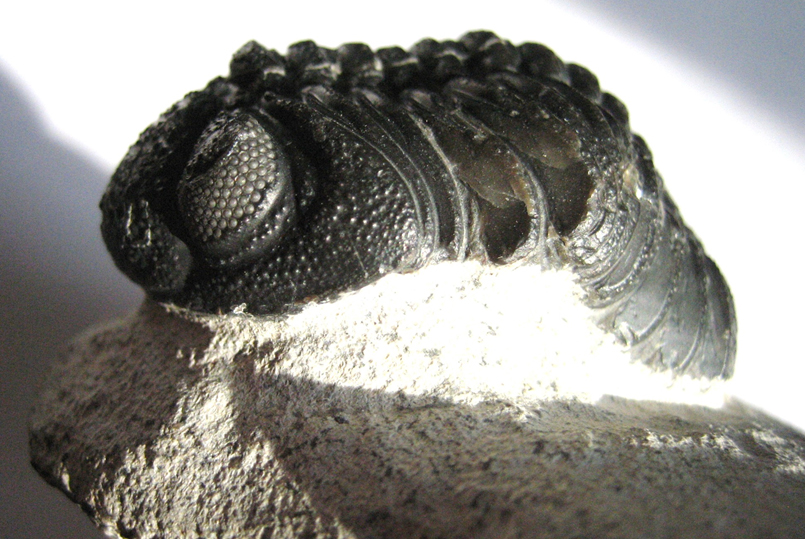
Credit: www.goodfreephotos.com [CC BY 2.0 (http://creativecommons.org/licenses/by/2.0)], via Wikimedia Commons.
Eyes are not just the windows to the soul. They’ve been key to the evolution of life as we know it.
Predators developed binocular vision, to give them better depth perception when hunting prey. As a response, prey developed eyes on the sides or tops of their heads, for a wide field of view to detect predators. A raptor can spot a rabbit from more than a mile away. Butterflies see ultraviolet light, to find flowers and mates. But there was a time long ago when life on Earth was blind.
Then, about 500 million years ago, trilobites evolved. Much like today’s horseshoe crabs, they scuttled around the ocean floor looking for marine worms or carrion to scavenge. And to help find food, they began to develop eyes.
This amazing new capability allowed them to spread across the globe, adapt to different environments, and diversify into as many as 20,000 species, ranging in size from a fingertip to trash-can lid.
Trilobite eyes forced other organisms to evolve defense mechanisms like locomotion and camouflage—and eyes—to compete with them for food and to avoid being eaten. Some scientists think that trilobite eyes encouraged the explosion of diverse life forms that led to the dinosaurs.
Vision enabled trilobites to dominate Earth for more than 100 million years. And although they eventually went extinct, vision has survived across the millennia.
So next time you use your eyes, thank the lowly trilobite for getting the party started.
Background
Synopsis: We depend on our vision for a multitude of tasks, but when and why did vision evolve?
- Vision is one of our most important senses, enabling us to navigate our world with color discrimination, depth perception, and motion detection.
- Eyes have adapted differently to meet the needs of various organisms.
- Some arthropods have a 360-degree field of view.
- Vision of nocturnal creatures is tuned for sensitivity to low light.
- Predators have binocular vision to improve depth perception.
- Prey, like horses and rabbits, have eyes located to maximize the field of view with monocular vision.
- Trilobites are one of the first groups preserved in the fossil record to develop complex eyes. Earlier organisms may have had light-sensitive spots, but the beady-eyed trilobite can teach us about the origin of eyes … and sight.
- Trilobites have an amazing record on Earth as a successful survivor.
- They first appeared in the fossil record about 540 million years ago in the Cambrian period, with more-widespread appearance 521 million years ago.
- They were one of the earliest organisms to leave their exoskeletons as fossils.
- They dominated Earth during the Cambrian explosion of life but declined in the Devonian extinction, when oxygen was depleted in the oceans, leaving only one order that lived another 125 million years until the Permian “Great Dying.”
- Trilobites persisted for about 270 million years, while human ancestors—the earliest walking hominids—can only be traced back about 4 million years.
- Trilobite fossils flourished and have been found on every continent, and they diversified into more than 20,000 species.
- The largest was 28 inches long, and the smallest was less than a millimeter long.
- Some had wild spines and ornamentation, and others were smooth and rounded; some rolled up like a pill-bug when threatened.
- Most trilobites were benthic feeders that left footprints on the seabed as they hunted or scavenged; some learned to swim and fed on plankton.
- Some trilobites living in low light were blind, but others developed amazing ornate compound eyes with up to 15,000 lenses, like those we see in insects and crustaceans today.
- The earliest trilobite eyes are 525 million years old, found in China.
- Most fossilized trilobite eyes include hexagonal lenses made of calcite.
- In 2013, scientists discovered a particularly well-preserved specimen and were able to map the entire visual system of the trilobite, which was very similar to that of present-day horseshoe crabs—often referred to as a living fossil!
- Trilobites had one principal and two less-prevalent forms of eyes, varying in the organization of the lens, cornea, and sclera to suit their way of life.
- Trilobite eyes provided them with a huge advantage as a predator and drove their own success as well as significant evolutionary changes in their prey—like locomotion.
- The incredible diversification of the Cambrian explosion may have been caused in part by the evolution of trilobite eyes, which required their prey to evolve very rapidly—or pay the ultimate price!


